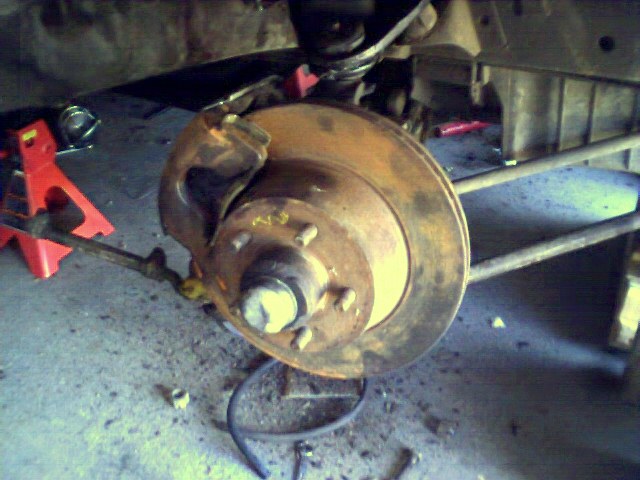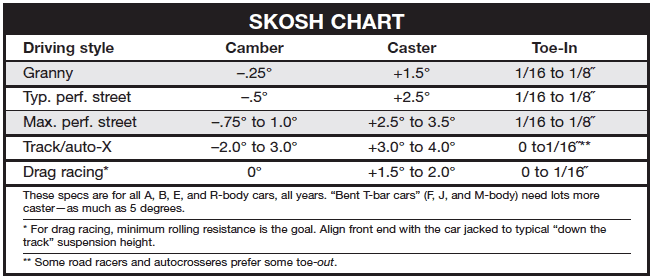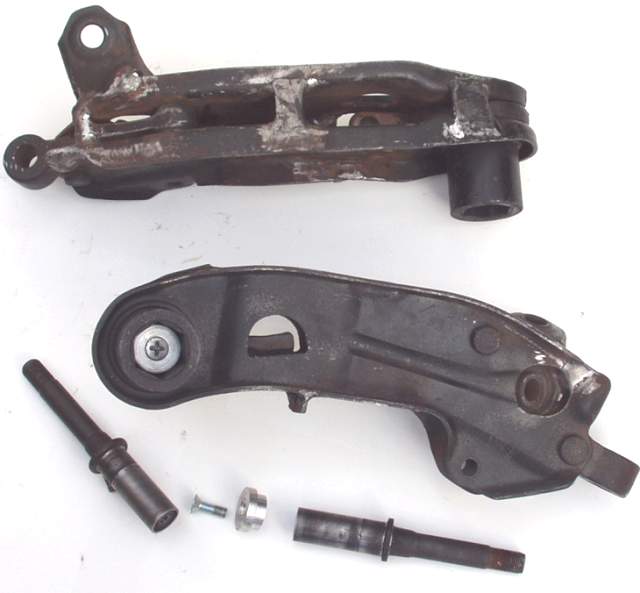
Brake Swaps for Mopar Musclecars
The truth of the matter is that OEM braking systems installed on muscle-era Mopars are just not on par with todays standards. The reason for this is simple: the ultimate degree of deceleration force i limited by available traction. The old bias-ply G70-14's, while state-of-the-art more than two decades ago, are light-years behind todays sticky meats in terms of traction and, therefore, potential maximum deceleration force.
During deceleration, the energy motion is converted to heat energy by the brakes. The rate of deceleration possible with todays higher-tech tires means that kinetic energy of a moving vehicle must be converted to heat in a shorter period of time at the tires' adhesion limit (maximum braking). This shoots the breaking system out of its'original design parameters,and it goes up in smoke. The kind of heat dissipation demanded just isn't designed into the system. Even if your car was factory fitted with front disc breaks and you upgraded to semi metallic pads, you may find the brakes dissappointing.
Fortunately for the Mopar performance enthusiast, Chrysler Corp. later developed improved, higher capacity brakes. These brakes can be readily incorporated into earlier ('62 and newer) B-and E- body Mopars. In this feature we will outline the relevent components, their applications and how they relate to Mopar brake conversion possibilities.

Disc Brake Conversion
Most of you are swapping a 67-73 Mopar from disc to drum brakes.
The easiest swap is a donor car of a 73-76 A-body that already has disc
brakes
This is what you will need from the Donor car:
Master Cylinder for drum/disc brakes
Frame rail brake proportioning valve
New hoses from frame rail to calipers - don't try to re-use the old ones but take them with you to match them up
Steering knuckle (spindle) from a 73 and up disc brake car (pn 3402628 and 3402629)
Caliper, bearings, caliper bracket, bolts, and rotor
Upper control arms on the early A body cars use a smaller dia. stud ball joint. If you find that the upper ball joint part numbers are the same for your car as those of a 73-76 A-body disc brake car then you can use the original upper control arm. All you need care about is that the upper ball joint stud is the correct size to fit the hole in the knuckle for the disc brakes.
New rims (wheels) to fit 4-1/2" bolt circle and to clear larger diameter caliper inside the wheel. Most drum brake wheels will rub on the inside
against the caliper - check to make sure.
You may want to replace the brake lines by bending your own or just
getting a pre-made set. Cars that are over 20 years old usully have rusted
lines because of moisture trapped within the line.
Pick up a set of two inner bearings with races , two outer with races
and a two grease seals as the originals are usually pretty worn. It's a
good idea to get yourself a 'bearing packer" tool a it makes life a lot
easier, as will a simple "race installer" tool to seat the races into the
rotor.
NOTES:
When you get the hoses between the frame rail and caliper, make sure
you get the copper washers and new caliper brake bleeder valves. The original
hollow bolt holding the hose block to the caliper is hard to find so do
not lose them. Also, shop around for rebuilt caliper pricing - cost should
be around $35 each with an exchange and get new anti-rattle clips, some
rebuilders include them others don't so ask. Choose the store which has
the least net cost and the parts in stock - one store may say $55 each
with a $20 core and the other a $45 each with a $5 core. The $55 is a better
deal if they have them in stock because it will cost you $35 not $40.
Check the condition of the rotor and look for the minimum diameter near
where the studs poke out of the caliper. Try to rotate the rotor without
the caliper and hold a stationary stick, rod, etc to see if there is a
lot of side-to-side runout. In addition, check the thicness with a caliper
and perform both these checks especially if you have a choice of cars to
pull from. Buy yourself a brake bleeder wrench and one that fits the nuts
on the lines - regular wrenches usually slip or round off the nuts on the
lines.
Above all, use your noggin! Compare the replacement part numbers at
your parts store to see if a certain master cylinder from a B or E body
car with disc brakes is the same. Try the same thing for the caliper and
rotor as well - sometimes even looking into the J.C. Whitney catalog will
verify this. Always double check your 'quick and dirty' cross-reference
sources in case there is a typo in the text or wrong part listed.
Note: The 73-74 E-body cars have the same part number disc brake spindle
as the disc brake single-caliper 73 and up A-body cars. This means you
can use the E-body spindle
Spindle
The spindle to use when installing late-model breaks was introduced on 1973 B-body cars, and carried over on all later B- (Coronet,Satelite,Road Runner,Charger,GTX,R/T, Belvedere,Super Bee, Cordoba,'76-78 Fury,'77-78 Monaco and '78-79 Magnum), F-('76-80 Volare, Aspen,Road Runner and R/T), J-('80-83 Mirada and Cordoba), M- ('77-78 Diplomat, LaBaron, Caravelle and 5th Ave.) and R- ('79-81 New Yorker and St.Regis) bodies. Yes, even the transverse torsion bar cars used the same spindle. This spindle was designed to accept the post-'73 rotors, which incorporated a larger inner wheel bearing and seal.
The late model spindle retained the same steering arm/ball joint mount spacing specifications as the earlier B- and E- body spindle, and this is the key that makes late-model break swaps possible. It will bolt directly in place of the earlier spindle, and therefore alows the installation of any of the front disc setups found on te varaious post-'73 B-,F-, J-, M- and R- cars.
Unlike the '70-72 B-, and all E-body spindles, the late model spindle mounts the caliper to the rear of the rotor. This allows fitting disc breaks to the '66-69 B-bodies equipped with the factory front sway bar without interference problems.
Rotors
The post-'73 B-,F-,J-,M-and R- body rotors were all of the unicast design and came in two diameters: the huge 11.75-inch unit and the smaller 11-inch version. The unicast design signifies that the hub and rotor are cast as a single piece rather than two seperate components, as in earlier designs. It also has the advantage of having a fixed alignment with the hub, but is more subject to heat stress in the hub area. This problem was addressed by Chrysler by using massive stiffening ribs in the inside hub area on all heavy duty applications.
Basically, the rotor selection can be broken down into four types: 11.75" and 11" in either standard of HD versions. The 11.75" rotors are a tremendous improvement over any of the earlier drum or disc brake setups. The advantage should be readily apparent to anyone who has ever tried more than two consecutive high- speed stops with the factory drum brakes. If your Mopar already has the factory 11" disc with semi-metallic pads, you are in much better shape. However, under extreme repeated abuse, these brakes will also cook themselves.
The 11.75" rotor will gain approx. 11% in swept area over the 11" disc. Also, since the caliper is further out from the axle center line, the same amount of force at the caliper exerts a greater force at the rotational axis(like a longer handle ratchet on a stubborn bolt). When changing to the 11.75" rotors, keep in mind that you will need 15" wheels. The factory applications for the 11.75" rotors include '76 and up B-and R-bodies. The 11" rotors should only be considered if you want to switch from drum brakes to disc and have to keep the 14" wheels. The applications for the 11" rotors cover '73 and up RWD cars other than those listed above.
Calipers
There were two types of calipers used with the late-model brakes: floating and sliding. Earlier cars used the pin mount floating caliper. This design was attatched to the caliper mount (adaptor) via two long screw-in pins, floating the caliper on rubber bushings at each end. If you are into high performance equipment, I hope the word "rubber" raised a red flag (more on that later}. This is the same design used on non unicast '70-72 B- and E-body applications.
The sliding caliper featured machined bosses at each end that fit into rails machined into the adaptor. the caliper is retained by clips that bolt on top of the adaptor, allowing the caliper to slide in the adaptor rails. The sliding caliper was found on '76 and up F- bodies, and in '78 replaced the the floating unit accross the board. The sliding caliper is superior to the floating unit in four ways:
1, It maintains percise alignment with the rotor because of it's metal to metal sliding arrangement;
2, It offers a faster and more positive application and release rate; 3, It is much more ridged in installation(I've seen floating caliper pins bend under severe duty use); and,
4, The floating caliper's rubber bushings allow the caliper (and it's pads with it) to deflect. Go with the sliding-type calipers.
Caliper mounts (adapters)
There are two rotor diameters, and therefore two caliper adapters: a long one for the large rotors and a short one for the small rotors. This goes for both floating and sliding caliper adapters, a long and short version of each.
Master cylinders
The drumbrake master cylinder can be used, but it must be modified by removing the residual pressure check valve. This valve was used to keep the wheel cylinder under a slight pressure to press the cup seal lips tight against the wheel cylinder bore to prevent it from oozing fluid. improved wheel cylinders have made this obsolete, and some rebuilt master cylinders do not incorporate them. Check your master cylinder for this valve they are quite easy to remove.
If your car is not equiped with a tandem master cylinder, GET ONE. The old single cylinder setup is plain dangerous and unsuitable.
The only question is power brakes.A booster generally is unnecessary if using a 1" piston master cylinder. Of course, if you have a heavy car with the smaller 11-inch disks you may be getting on the pedal pressure borderline. Use common sense. If the pedal pressure is too high get a booster.
Proportioning valve
The proportioning valve must be changed when swapping from drums to discs. There are two approaches. You can get a Mopar Performance unit part No.4120999, which is the best way to dial in the exact front/rear ratio. You could also adapt a production valve from a factory late model disc/drum car with the same size front discs you've installed, you will end up close to the ideal ratio. Allways road test to be sure the rear brakes dont lock up before the fronts.
You will find that when changing from drum to discs, the various size brake lines will not correspond to the holes tapped in the disc/drum proportioning valve (even with the Mopar Performance piece). Do not cut the lines and reflare them in an attempt to change the nuts. The lines take a double rolled flare. It is very difficult to reflare them properly, even with the correct tools. The lines are prone to splitting at the seams in a most unnoticable way. There is a full assortment of adapter fittings available at most auto parts stores. They will allow the lines to be fitted directly to the new valve.
Recommendations
Now that you have a full understanding of what components are available, you need only choose your setup. First, as we discussed, the sliding calipers are the only way to go. The next question is which size rotor to use.
When it comes to brakes, the old belief of "bigger is better" rings true. The 11.75" assembly is a high capacity brake system and is the conversion to choose. The only reason to choose the 11" rotors is if you need to retain the 14" rims. Getting into stock applications for the 11.75" rotor with sliding callipers, the '78-and up B- and R- bodies came equiped with this combination. This includes the Magnum, Cordoba, St. Regis and New Yorker. The St. Regis was a popular police car and was equiped with the HD rotors.
Most aftermarket rotors will come with the HD-type stiffening ribs. Any one of these cars would provide the complete 11.75" slider brake assembly, spindles etc. If you are after the 11" slider-type brakes,the whole assembly can be found on F-,J- and M- body cars.
Alignment notes/suspension geometry
The late model spindle installation will require you to realign your car. Because the upper ball joint mount is positioned slightly higher and inboard of the original spindles it will increase the caster angle. This is somthing that most Mopars could use, as with a lowered front suspention height, often there is not enough adjustability in the control arm cams to get the suspention out of a severe negative camber situation. The late model spindles have the advantage of putting adjustability back towards the center in these cases. For those of you who lose the inside two inches of your front tires no matter how often the wheels are aligned, this can be reason enough for the swap. If more negative camber needs to be dialed into the suspention, simply adding a machined washer between the spindle and ball joint/steering arm will bring it out as much as desired. This is seldom necessary, but included for reference.

Welded and modified lower control arm:
